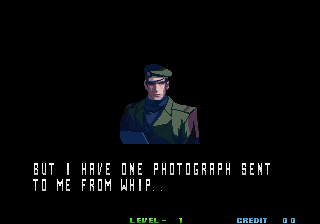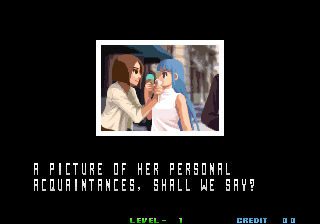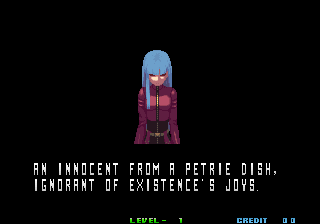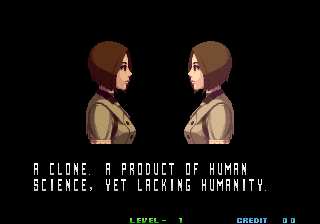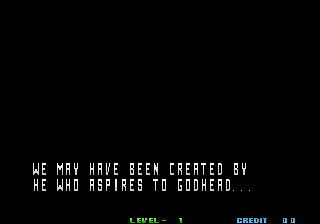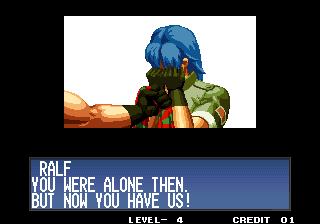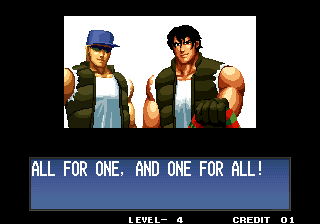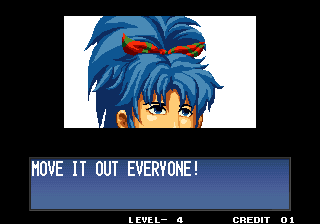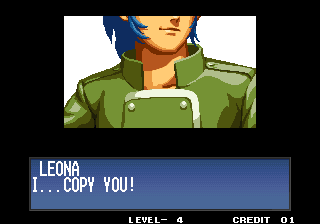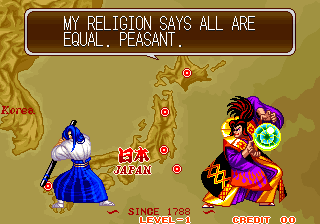Learning About SNK Part 3: Where I talk about story and no gameplay
NOTE: The following contains spoilers for Kula and Whip’s stories in The King of Fighters 2001. This will also contain some discussion of optimistic nihilism, questioning the meaning of one's existence and the concept of a god, so heads up if you're sensitive to existential stuff. It's relevant, I swear. (In case you're wondering, I'm agnostic)
 Perhaps this is a vocal minority, but it seems that most fighting game fans don't particularly care about story. Even die hard fans of Guilty Gear and BlazBlue’s competitive scenes seem to frequently encourage not to bother with trying to understand those games’ stories because they consider them complete incoherent nonsense. Maybe this isn't helped by the fact that most fighting game lore you can read on wikis sounds extremely stupid out of context when you haven't bought into the colourful manga world of the series in question. Did you know, for instance, that in Street Fighter canon, M. Bison has a horse? See, this one time M. Bison, the fascist dictator, saw a dying horse, and something about the plight of that dying horse tugged at his shrivelled up heartstrings. As a result, he used Psycho Power in order to de-age and heal the horse. The horse’s alignment is listed as evil on the Street Fighter wiki, I think because it has Psycho Power in it now and apparently Psycho Power is inherently evil. The horse is evil. Okay. That's not even the goofiest bit of Street Fighter lore I learnt on that Wiki binge. Did you also know that Charlie, Guile's friend who was killed by M. Bison, was brought back to life by being turned into a Frankenstein’s monster by the illuminati? My point is, you don't have to go far in the Street Fighter wiki to find something that is hilariously stupid.
Perhaps this is a vocal minority, but it seems that most fighting game fans don't particularly care about story. Even die hard fans of Guilty Gear and BlazBlue’s competitive scenes seem to frequently encourage not to bother with trying to understand those games’ stories because they consider them complete incoherent nonsense. Maybe this isn't helped by the fact that most fighting game lore you can read on wikis sounds extremely stupid out of context when you haven't bought into the colourful manga world of the series in question. Did you know, for instance, that in Street Fighter canon, M. Bison has a horse? See, this one time M. Bison, the fascist dictator, saw a dying horse, and something about the plight of that dying horse tugged at his shrivelled up heartstrings. As a result, he used Psycho Power in order to de-age and heal the horse. The horse’s alignment is listed as evil on the Street Fighter wiki, I think because it has Psycho Power in it now and apparently Psycho Power is inherently evil. The horse is evil. Okay. That's not even the goofiest bit of Street Fighter lore I learnt on that Wiki binge. Did you also know that Charlie, Guile's friend who was killed by M. Bison, was brought back to life by being turned into a Frankenstein’s monster by the illuminati? My point is, you don't have to go far in the Street Fighter wiki to find something that is hilariously stupid.
 This is not a condemnation of Street Fighter’s story however. After all, I am deeply invested in the story of The King of Fighters series, a series in which equally stupid things also happen, but in KoF it’s even harder to take seriously thanks to terrible translations that are filled with poor grammar and typos as were standard for SNK games for the entire Neo Geo era. Did you know that Chin, the tiny alcoholic old man that trains Athena and Kensou, hates pandas? When Chin gets super drunk he'll immediately stumble his way to the nearest panda and pick a fight with them for no reason other than his completely unexplained personal vendetta against pandakind. As such, when playing as Chin’s team in King of Fighters 2000, one of your options for a striker you can replace Chin with is a giant panda that you can sicc on your opponent, who attacks by somersaulting into the enemy. I like to imagine that this giant panda is like the giant chicken from Family Guy, Chin’s eternal arch rival.
This is not a condemnation of Street Fighter’s story however. After all, I am deeply invested in the story of The King of Fighters series, a series in which equally stupid things also happen, but in KoF it’s even harder to take seriously thanks to terrible translations that are filled with poor grammar and typos as were standard for SNK games for the entire Neo Geo era. Did you know that Chin, the tiny alcoholic old man that trains Athena and Kensou, hates pandas? When Chin gets super drunk he'll immediately stumble his way to the nearest panda and pick a fight with them for no reason other than his completely unexplained personal vendetta against pandakind. As such, when playing as Chin’s team in King of Fighters 2000, one of your options for a striker you can replace Chin with is a giant panda that you can sicc on your opponent, who attacks by somersaulting into the enemy. I like to imagine that this giant panda is like the giant chicken from Family Guy, Chin’s eternal arch rival.
Now, I am not opposed to dumb fun, so such stupidity is not even remotely close to a negative. Many of the stupid aspects of these games are funny and add to a campy charm. If all of the story scenes were total nonsense along these lines, that wouldn't really be an issue given that many of these games have very few cutscenes, so the comedic value wouldn't have a chance to wear thin. Play Dong Dong Never Die if you want to see how entertaining a fighting game that is complete incoherent nonsense can be. Genuinely, however, I enjoy the lore and characters of King of Fighters and I think there’s something special about the story in fighting games that deserves to be more appreciated and built upon.
 I feel that in many ways you can look at fighting games as a celebration of diversity. Street Fighter 2 set a standard that fighting games in its mould wouldn't just focus on a single martial art like early fighters such as IK+ or Yie Ar Kung Fu, but instead should depict all martial arts from across the world clashing against one another. As such, the colourful casts that are one of the major draws of the genre tend to be a very diverse bunch, with backgrounds for these characters as diverse as the backgrounds of the martial arts themselves, covering a wide spectrum of not just nationalities and martial arts styles, but also gender, age, body types and even LGBT+ representation in increasing amounts as of late. It's easy to find a character in fighting games that you especially identify with as a result. I, for instance, absolutely adore Ash Crimson. He 100% embodies the kind of gender expression I strive for every day, and having a gender non-conforming male character who is still comfortable with wearing headbands and nail polish being a lead character I can play as is really validating. I don't even mind that he's a little stinker and basically a villain protagonist, the fact that he's a bit of a bitchy gremlin only adds to him for me.
I feel that in many ways you can look at fighting games as a celebration of diversity. Street Fighter 2 set a standard that fighting games in its mould wouldn't just focus on a single martial art like early fighters such as IK+ or Yie Ar Kung Fu, but instead should depict all martial arts from across the world clashing against one another. As such, the colourful casts that are one of the major draws of the genre tend to be a very diverse bunch, with backgrounds for these characters as diverse as the backgrounds of the martial arts themselves, covering a wide spectrum of not just nationalities and martial arts styles, but also gender, age, body types and even LGBT+ representation in increasing amounts as of late. It's easy to find a character in fighting games that you especially identify with as a result. I, for instance, absolutely adore Ash Crimson. He 100% embodies the kind of gender expression I strive for every day, and having a gender non-conforming male character who is still comfortable with wearing headbands and nail polish being a lead character I can play as is really validating. I don't even mind that he's a little stinker and basically a villain protagonist, the fact that he's a bit of a bitchy gremlin only adds to him for me.
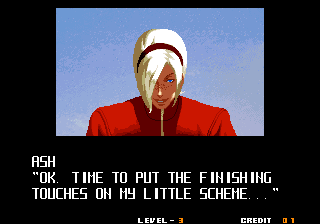 With a huge variety of characters comes a lot of different reasons for these characters to all be drawn to the epicentre of the plot, the fighting tournament. It's not as cut and dry as simply “I want to prove myself and win prize money”, characters in King of Fighters are also often agents investigating the seedier sides of the tournament or schemers looking to use the tournament for their own ulterior motives. There's a richness to the world of King of Fighters as a result, with the varied backgrounds of every character further expanding the setting through the organisations and locales the characters are involved with.
With a huge variety of characters comes a lot of different reasons for these characters to all be drawn to the epicentre of the plot, the fighting tournament. It's not as cut and dry as simply “I want to prove myself and win prize money”, characters in King of Fighters are also often agents investigating the seedier sides of the tournament or schemers looking to use the tournament for their own ulterior motives. There's a richness to the world of King of Fighters as a result, with the varied backgrounds of every character further expanding the setting through the organisations and locales the characters are involved with.
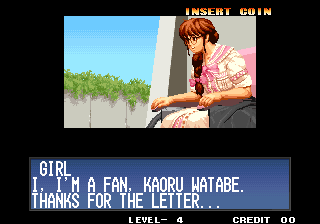 This leads me into the best way to engage with this lore and world building in The King of Fighters; the team stories. For every single canonical game in the series, SNK has published short stories on their website for every individual team, explaining where they came from and why they're entering the tournament. I highly recommend reading these as many of the endings in-game directly reference these stories and serve to tie up the plot threads they set up. They're not exactly… amazingly written, I'll admit. The translations are pretty janky and full of grammatical errors, but if you can deal with that (and you almost certainly can if you're a SNK fan) there's a ton of fun character arcs and interactions to really help bring these colourful characters to life just a bit more. It gives them a chance to show interactions outside of just fighting each other and nothing else, letting you see how they interact in casual environments like cafes and bars, shows what an average day in their life looks like outside of the tournament and shows us a side of this world that we'd never see through the constraints of an arcade fighting game. There's a lot of charm all around here, such as Terry always taking time to help and support the local orphaned kids due to him growing up an orphan himself, or the friendship Athena forms with a fan of hers that was withdrawn after suffering a leg injury that left her in a wheelchair but was inspired to get back out and face the world again after seeing Athena fight so bravely in previous tournaments.
This leads me into the best way to engage with this lore and world building in The King of Fighters; the team stories. For every single canonical game in the series, SNK has published short stories on their website for every individual team, explaining where they came from and why they're entering the tournament. I highly recommend reading these as many of the endings in-game directly reference these stories and serve to tie up the plot threads they set up. They're not exactly… amazingly written, I'll admit. The translations are pretty janky and full of grammatical errors, but if you can deal with that (and you almost certainly can if you're a SNK fan) there's a ton of fun character arcs and interactions to really help bring these colourful characters to life just a bit more. It gives them a chance to show interactions outside of just fighting each other and nothing else, letting you see how they interact in casual environments like cafes and bars, shows what an average day in their life looks like outside of the tournament and shows us a side of this world that we'd never see through the constraints of an arcade fighting game. There's a lot of charm all around here, such as Terry always taking time to help and support the local orphaned kids due to him growing up an orphan himself, or the friendship Athena forms with a fan of hers that was withdrawn after suffering a leg injury that left her in a wheelchair but was inspired to get back out and face the world again after seeing Athena fight so bravely in previous tournaments.
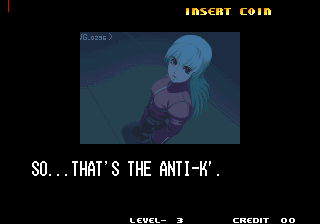 There's also the weird fact that even though these characters don't age (I believe the characters have only aged one year over the span of 15 annual tournaments) they still very much grow and develop year after year, and it's satisfying to see those character development arcs gradually build up and be resolved over the span of multiple games and team stories. I really enjoyed this about the NESTS saga in particular, spanning King of Fighters ‘99, 2000 and 2001. For instance, Whip and Kula were both essentially “manufactured” by NESTS, a shadowy organisation bent on world domination, with a focus on human experimentation and supersoldier projects. Whip was a clone that from birth was specifically created for the sole purpose of combat. Kula meanwhile was grown from a petri dish with the sole purpose of being an Anti-K', a weapon designed to kill NESTS’ greatest enemy. Kula, by the time of the games, is the only one that remains loyal to NESTS, understandably so as they're the only family she has and the only life she's ever had. Nearly everyone associated with NESTS is a victim, manipulated into servitude and gaslit into believing NESTS is all they have. So, at the end of this saga when NESTS is defeated, seeing Whip and Kula, former enemies, now becoming best friends, relating over the similar circumstances of their creation, and now, without being a cog in NESTS' master plan with no agency, are finally able to live life on their own terms? Immensely satisfying payoff, made all the more heartwarming by Heidern revealing a photo of Kula and Whip enjoying ice cream together at a cafe as a stinger for the whole arc.
There's also the weird fact that even though these characters don't age (I believe the characters have only aged one year over the span of 15 annual tournaments) they still very much grow and develop year after year, and it's satisfying to see those character development arcs gradually build up and be resolved over the span of multiple games and team stories. I really enjoyed this about the NESTS saga in particular, spanning King of Fighters ‘99, 2000 and 2001. For instance, Whip and Kula were both essentially “manufactured” by NESTS, a shadowy organisation bent on world domination, with a focus on human experimentation and supersoldier projects. Whip was a clone that from birth was specifically created for the sole purpose of combat. Kula meanwhile was grown from a petri dish with the sole purpose of being an Anti-K', a weapon designed to kill NESTS’ greatest enemy. Kula, by the time of the games, is the only one that remains loyal to NESTS, understandably so as they're the only family she has and the only life she's ever had. Nearly everyone associated with NESTS is a victim, manipulated into servitude and gaslit into believing NESTS is all they have. So, at the end of this saga when NESTS is defeated, seeing Whip and Kula, former enemies, now becoming best friends, relating over the similar circumstances of their creation, and now, without being a cog in NESTS' master plan with no agency, are finally able to live life on their own terms? Immensely satisfying payoff, made all the more heartwarming by Heidern revealing a photo of Kula and Whip enjoying ice cream together at a cafe as a stinger for the whole arc.
To get a little philosophical, there's some parallels here to the concept of optimistic nihilism. The man pulling the strings behind NESTS is Igniz, an insane space bishounen with a god complex. In short, he believes that if he takes over the world with clones and artificial life forms of his own creation with undying loyalty to himself, he has essentially established himself as a creator god. The plan Igniz has for his creations in this sense is essentially “God’s plan”, the concept that a divine being created you with a purpose to fulfil in your life that's part of a larger plan being a philosophy that many followers of Abrahamic religions swear by and find comfort in. The optimistic nihilist meanwhile believes that there is no such divine purpose for their existence, and while others may fall into despair over the lack of meaning in anything, the optimistic nihilist recognizes that this means that there's no correct predefined way to exist, and any meaning attached to their life is theirs to create for themselves. Nothing in life matters except what matters to you and that is how they find true freedom. Kula and Whip reject their god and break free of their predetermined roles Igniz assigned them, thus giving them freedom and genuine happiness, and that is what makes their lives worth living. That is why the final shot of Kula and Whip having ice cream together is so satisfying.
(Dammit SNK you make it so much harder to defend your writing when your translations during some of the most meaningful scenes are this bad…)
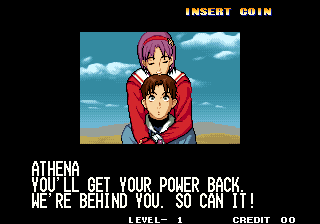 This is just two characters of a large roster of hundreds of characters, each of which have their own arcs and involvement in the tournaments. I could just as easily bring up arcs for characters like Leona and Heidern of the Ikari team, two of my surprise favourites who have a ton of growth involving themes such as rejecting destiny, letting go of the past and found family. Some of my favourite scenes in the series involve Ralf and Leona, primarily because I think the way Ralf makes a clear effort to fill an older brother kind of role for Leona is really cute. Even jokey characters such as Kensou, the down-bad Athena fanboy with a dumpling addiction, ended up being a favourite and someone I got genuinely interested in seeing the growth of. His arc mainly deals with his feelings of inadequacy and inferiority which are gradually overcome with each game, as he gets closer to his full potential every tournament. I’m genuinely shocked by how much I love Kensou and Ralf considering that I usually can’t stand simping fanboy characters or macho military soldier characters, so it’s astonishing to me that King of Fighters made me adore characters from both of those archetypes.
This is just two characters of a large roster of hundreds of characters, each of which have their own arcs and involvement in the tournaments. I could just as easily bring up arcs for characters like Leona and Heidern of the Ikari team, two of my surprise favourites who have a ton of growth involving themes such as rejecting destiny, letting go of the past and found family. Some of my favourite scenes in the series involve Ralf and Leona, primarily because I think the way Ralf makes a clear effort to fill an older brother kind of role for Leona is really cute. Even jokey characters such as Kensou, the down-bad Athena fanboy with a dumpling addiction, ended up being a favourite and someone I got genuinely interested in seeing the growth of. His arc mainly deals with his feelings of inadequacy and inferiority which are gradually overcome with each game, as he gets closer to his full potential every tournament. I’m genuinely shocked by how much I love Kensou and Ralf considering that I usually can’t stand simping fanboy characters or macho military soldier characters, so it’s astonishing to me that King of Fighters made me adore characters from both of those archetypes.
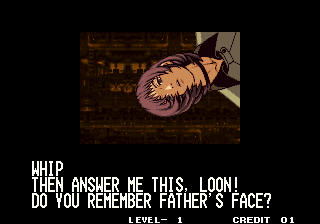 Ultimately however, these stories are primarily focused on characters over more coherent storytelling. Let me make something clear about the NESTS saga of King of Fighters; it is a complete and utter mess. For instance, at the end of 2000 an entire major town that much of King of Fighters is set around is nuked off of the map. It’s completely destroyed and it is just, not addressed. Like, at all. The town is just rebuilt next game without explanation with seemingly no casualties. They just expect you to forget they nuked a town. The narratives are frequently absurd and ridiculous, not helped by SNK’s translations being questionable at best, with awkwardly crammed in jokes that often feel horribly out of character and misplaced. Whip gets this especially badly in her ending in ‘99, where she can’t resist adding a corny insult to the end of nearly every single line of dialogue she has, in spite of the fact that it’s meant to be an emotional and tragic scene that leaves her sobbing afterwards. The sober tone is completely undone by Whip calling the character she’s mourning names like “puke”, “gruel breath” and “loon”.
Ultimately however, these stories are primarily focused on characters over more coherent storytelling. Let me make something clear about the NESTS saga of King of Fighters; it is a complete and utter mess. For instance, at the end of 2000 an entire major town that much of King of Fighters is set around is nuked off of the map. It’s completely destroyed and it is just, not addressed. Like, at all. The town is just rebuilt next game without explanation with seemingly no casualties. They just expect you to forget they nuked a town. The narratives are frequently absurd and ridiculous, not helped by SNK’s translations being questionable at best, with awkwardly crammed in jokes that often feel horribly out of character and misplaced. Whip gets this especially badly in her ending in ‘99, where she can’t resist adding a corny insult to the end of nearly every single line of dialogue she has, in spite of the fact that it’s meant to be an emotional and tragic scene that leaves her sobbing afterwards. The sober tone is completely undone by Whip calling the character she’s mourning names like “puke”, “gruel breath” and “loon”.
Regardless, as all I've said up to this point likely already suggests, I believe there is still a lot of value there surrounding the growth of the characters around the absurd plot. The absurd cartoon villains can still be used to launch more introspective themes and development for the heroes they are up against, and while those heroes are also ridiculous, the absurdity makes them fun while the actual growth they show makes them engaging. I love that you don't get the full picture until you play through the games as every team to get their unique endings. I may have spoiled where Whip and Kula ended up after 2001, but that's two characters of a roster of 40, each of which get a different resolution from the conclusion of the saga. I'm one of those weirdos that likes the stories of the Sonic Adventure games where they show how the events of the same plot play out differently from different perspectives. Maybe you'll see a robot have an existential crisis, or maybe you'll see a confused clueless cat somehow wrapped up into this mess in spite of never having the slightest idea what is going on. As a result you see how all kinds of people are affected and grow due to the events that they’ve all gone through in a really satisfying way that makes the world feel alive and evolving.
Anyway, in spite of all of the teasing I had directed at SNK’s translations, let me end this blog post with quite possibly the greatest line SNK’s translators have ever written, as a palette cleanser.
Absolute perfection. SSS+ tier. Actually made me laugh out loud, good job SNK.
Page written by MSX_POCKY, 7th November 2024
